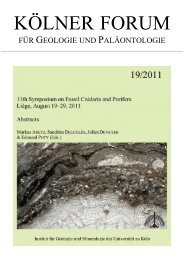Download (6Mb) - USP Electronic Research Repository - The ...
Download (6Mb) - USP Electronic Research Repository - The ...
Download (6Mb) - USP Electronic Research Repository - The ...
Create successful ePaper yourself
Turn your PDF publications into a flip-book with our unique Google optimized e-Paper software.
Benthic Marine Algae of Rotuma Island 365<br />
and road to reach the swamp, which occurs in depressions at or below sea-level. This observation seems<br />
to contradict an earlier report by Dunlap and Singh (1980) that mangroves do not occur on Rotuma,<br />
although perhaps the authors were referring only to coastal mangrove habitats.<br />
<strong>The</strong> island is 6" north of Fiji and is noticeably warmer. July temperatures rarely drop below 25OC,<br />
and daytime temperatures can rise up to 35°C. Water temperature ranges from 26-32°C (pers. obs.).<br />
<strong>The</strong> prevailing winds are east to south except during December, January, February and March, in these<br />
months, they vary from north to west (Gardiner 1898). A west-north-west current at approximately<br />
1 kph surrounds the island (Fiji Ministry of Agriculture and Fisheries 1983). Rain is frequent and<br />
regular (weekly; about 3550 mm yrl; Woodhall 1987) and hence droughts are uncommon. Hurricanes<br />
which normally hit neighbouring Fiji every 3 years or so rarely affect Rotuma, the last major hurricane<br />
to hit the island being Bebe in 1972 which caused widespread destruction.<br />
Reef Structure<br />
<strong>The</strong> reefs are in most cases fringing except in two places (Maka and Hapmafau Bays), where they<br />
approach the barrier class and enclose a shallow lagoon. <strong>The</strong> reefs are between 100-1500 m wide and<br />
can be quite exposed at low tide, drying between 0.6 to 1.5 m at each new and full moons (when tidal<br />
ranges are greatest). <strong>The</strong>re are no mudflats or coastal marine mangrove areas on Rotuma, but Maka Bay<br />
has extensive seagrass beds of Syringodium isoetifolium and a somewhat muddier substratum owing to<br />
its lagoon and relative protection from wave action leading to sediment accumulation. At the other<br />
extreme, Lopta reef is probably the narrowest on the island, being only 60-100 m wide in places and<br />
considerably exposed. Consequently, algal habitats in the various Rotuman reefs differ according to<br />
their extent and degree of exposure. Among the main constituents of the reefs are Acropora spp., except<br />
at Maka Bay and 'Ahau where brittle Pavona decussata Dana rubble is dominant. <strong>The</strong> latter species of<br />
coral forms an almost continuous pavement on the outer reef at Maka Bay.<br />
Dominant Species<br />
A distinct north-south disjunct of algal distribution was observed on the island, chiefly a result of<br />
the different habitats on opposite coasts (fairly deep and sandy on the north, more rocky and exposed at<br />
low tide in the south). Typical and dominant northern species include a wide range of Halimeda and<br />
Caulerpa spp., and widespread plants of Melanamansia glomerata that inhabit rubble of Acropora sp.<br />
on reefs from Mea to Oinafa. In the south, however, only one species of Halimeda (H. opuntia) was<br />
dominant, the rest of the species being chiefly small rhodophytes (Heterosiphonia, Ceramiales such as<br />
Herposiphonia) although the larger red alga, Meristotheca procumbens, was fairly abundant on the<br />
south-west coast. <strong>The</strong> eastern and western stations exhibited characters from both northern and southern<br />
habitats. <strong>The</strong> two small lagoons on the island had characteristic floras associated with their relatively<br />
calm waters. Maka Bay on the north coast was dominated by Sargassum polycystum, Rhodymenia<br />
divaricata, Laurencia sp., Gracilaria sp., and Enteromorpha jlexuosa; while Hapmafau Bay on the<br />
south of the Motusa isthmus was dominated by Caulerpa racemosa, Caulerpa serrulata and<br />
Chlorodesmis major.<br />
Systematics<br />
Chlorophyceae<br />
Ulvales<br />
Ulvaceae<br />
Enteromorpha Link in Nees 1820<br />
Enteromorphaflexuosa (Wulfen) J . Agardh 1883: 126; Taylor 1960: 61; Bliding 1963:<br />
73, figs 38-40; Womersley and Bailey 1970: 261; Dawes 1974: 67; Ngan and Price 1979: 4;<br />
Dong and Tseng 1984: 254, pl. 126, fig. 2; Koeman 1985: 166, figs 106-130; Lewis 1987: 4;<br />
Santelices and Abbott 1987: 5; Silva et al. 1987: 92; Littler et al. 1989: 22; Tsuda 1991: 42,<br />
Millar and Kraft 19946: 422<br />
Confervaflexuosa Roth 1800: 188 (type locality: Duino, near Trieste, Adriatic Sea).<br />
Ulvaflexuosa Wulfen 1803: 1 (nomen novum).<br />
Enteromorpha intestinalis (Linnaeus) Link var. tubulosa Kiitzing 1845: 247 (type<br />
locality: freshwater, Germany).

















